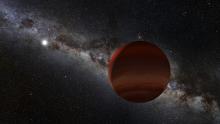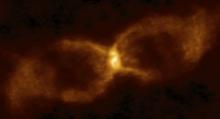Listen to today's episode of StarDate on the web the same day it airs in high-quality streaming audio without any extra ads or announcements. Choose a $8 one-month pass, or listen every day for a year for just $30.
You are here
Definitions
If you gaze into a dark night sky, you can see thousands of stars and as many as five bright planets. What you can’t see is the link between them, known as brown dwarfs. Although astronomers have discovered hundreds of them, they’re so faint that not a single one is visible to the eye alone.
A brown dwarf is described as a “failed star.” It’s generally heavier than a planet, but not massive enough to shine as a true star. But the difference between a brown dwarf and a giant planet can be hard to pin down. So some astronomers have suggested they be categorized based on how they were born.
A brown dwarf probably is born in the same way as a star — from the collapse of a cloud of gas and dust. If such a cloud is at least seven and a half percent the mass of the Sun, it begins to “fuse” the hydrogen in its core, so it shines as a true star. At lower masses, though, the core doesn’t get hot enough to start those reactions.
A planet forms from debris around a star. Chunks of ice and rock stick together to build larger bodies. If they get large enough, they can sweep up lots of leftover gas and dust, growing to giant proportions.
Based on the birth process, some planets may be more than a couple of dozen times the mass of Jupiter, the giant of our own solar system. On the other hand, the smallest brown dwarfs may be as little as a half dozen times Jupiter’s mass — muddying the difference between giant planets and failed stars.
Script by Damond Benningfield





